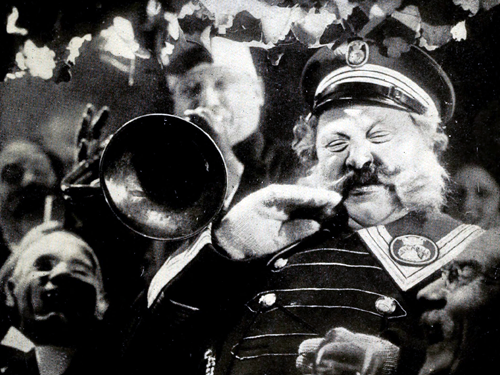
An aging doorman is forced to face the scorn of his friends, neighbors and society after being fired from his prestigious job at a luxurious hotel.
EN
“The Last Laugh can only be understood in a country where uniform is King, not to say God. A non-German mind will have difficulty in comprehending all its tragic implications.”
Lotte H. Eisner1
“The Last Laugh was almost the perfect film. It told its story even without subtitles - from beginning to end entirely by the use of imagery, and that had a tremendous influence on me.”
Alfred Hitchcock2
“The credit for Der Letzte Mann is attributable to three individuals, Murnau, screenwriter Carl Mayer, and cinematographer Karl Freund. Mayer was the most important scenarist of 1920s German cinema. His first credit was for the seminal The Cabinet of Dr. Caligari (Robert Wiene, 1919), where he began experimentation with the subjectivity and extreme psychological states that typifies German Expressionist cinema. Lotte Eisner, German art historian and expert on the period, explains that Mayer’s later scripts, particularly the collaborations with Murnau, combined expressionism with the other major strain of Weimar filmmaking; the realist Kammerspiel film, developed by theatrical producer Max Reinhardt, that pioneered a more subtle, psychologically nuanced style of acting to be performed in an intimate “chamber play” setting. Earlier Kammerspiel films had already begun experimenting with minimising intertitles, but Der Letzte Mann is the pinnacle of the form. A similar combination of the two styles can be found throughout Murnau’ work (he who began as an assistant to Reinhardt). In Nosferatu, he uses real settings and location shooting to create a shadowy, expressionist world. In contrast, Der Letzte Mann‘s realistic urban location is created out of elaborate sets built at the famed UFA studios. Freund, already an established cinematographer was the man responsible for seamlessly combining the two impulses in the film. To achieve this, he employed what has been called “the unchained camera,” a style of cinematography that was known for its free and energetic camera movement, as well as its use of unusual angles. The “unchained camera” helped provide a sense of a subjective point-of-view and is almost erotic in its unbridled eloquence. Freund would go on to shoot Fritz Lang’s Metropolis (1927) as well as many other classic German films, and then move to Hollywood where he won an Academy Award for The Good Earth (Sidney Franklin, 1937). In the final stages of his career, as the cameraman for I Love Lucy, he developed the three-camera system for television.”
Rahul Hamid3
- 1Lotte H. Eisner, Murnau (Berkeley: University of California Press, 1972).
- 2James N. Bade, “Murnau's The Last Laugh and Hitchcock's Subjective Camera”, Quarterly Review of Film and Video, 2006.
- 3Rahul Hamid, “Der Letzte Mann (The Last Laugh),” Senses of Cinema, July 2004.

